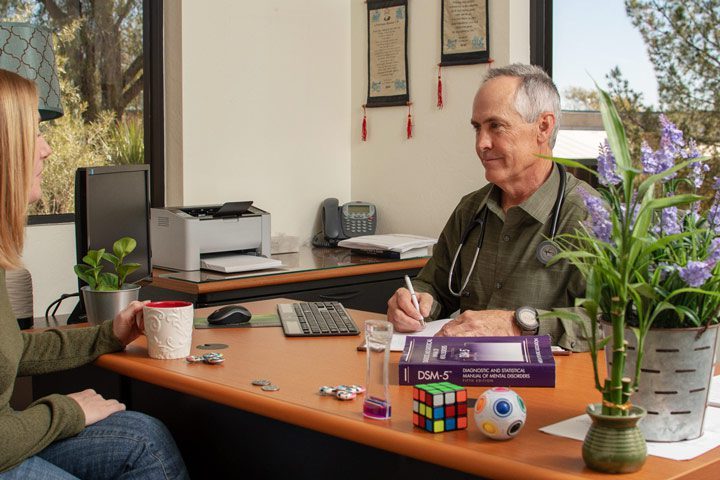
For many people to experience lasting recovery and renewed wellness, it’s not enough for an organization to simply address the symptoms of an apparent condition. When the professionals at Cottonwood Tucson talk about using whole-health principles, this approach is far more comprehensive than most people ever experience, and it leads to greater success.
About Tab Hoyt
Tab W. Hoyt is the chief of medical services and a nurse practitioner at Cottonwood. His role includes medically attending to all clients throughout their stay, completing a comprehensive history and physical examination, ordering and interpreting diagnostics, and prescribing medications and nutraceuticals. He also manages and supervises the medical ancillary staff and services. A member of Cottonwood’s team since 1990, he’s proud of how the facility’s clinicians acknowledge a complete integration of health and what that means for treatment.
“I believe patients begin to understand the importance of whole-body wellness quickly because we take the time to assess all issues with each visit. Education is paramount,” Hoyt says. “Clients are surprised by this. In today’s health care systems, they’re accustomed to short visits with long timeframes between follow-ups. At Cottonwood, all clients are seen on a weekly basis—some are seen daily. We’re not afraid to look and investigate.”
Treating More Than the Apparent Diagnosis
General practitioners are trained to solve problems, but often within a certain funnel of information: if a patient reports A, the problem must be B, and so treatment should be C. In most situations, this approach works fine. However, to help someone recover from substance use disorder (SUD) or process addictions; learn to manage mood or co-occurring disorders; and incorporate essential coping strategies for overcoming trauma, PTSD, or grief, a clinician must have a deeper understanding of the interconnected layers between these conditions.
“This means utilizing integrative medicine and a whole-person approach. Every patient at Cottonwood receives a psychiatric evaluation, medical evaluation, nutrition evaluation, fitness evaluation, all with follow-ups,” Hoyt says. “We use a team approach and incorporate all areas including physical, emotional, spiritual, and family systems to build an effective treatment plan. Because of this, we’re able to treat all problems, not just primary diagnosis.”
Hoyt has many surprising examples of how what someone initially presents links to other factors or conditions that require care. “Some psychiatric problems may originate from medical issues and/or are compounded by them, and are often overlooked. [The assessments we do] allow us to truly treat the individual from a whole-body approach,” he says. “The treatment plan may change with a resolution of problems or new findings. In some cases, diagnoses may change.”
Examples include:
- A patient diagnosed with bipolar disorder has brief periods of depersonalization and forgetfulness, but no trauma history. Hoyt says brain imaging and EEGs supported a more likely diagnosis of partial complex seizure disorder, promoting a change in the patient’s medication and treatment plan.
- A client who suffered from SUD, eating disordered behaviors, and self-harm denied a history of trauma, but when asked about head injuries, she recalled losing consciousness when her father threw her to the ground. Trauma work was added to her plan to aid recovery.
- One patient’s chief complaint was rage attacks. He had no history of mood disorder or abuse of anabolic steroids. During a routine laboratory evaluation, his calcium was elevated. This triggered a check of the parathyroid hormone, which was also elevated. Hoyt said he sent the patient for an ultrasound and discovered a parathyroid tumor. After excision, his rage resolved.
Discovering the Underlying Cause
“Often the underlying cause or start of a problem is overlooked and only symptoms are treated,” Hoyt says. “Additionally, several overlooked deficiencies can have a direct correlation to a person’s presenting symptoms and/or diagnosis,” such as:
- Alcohol use disorder: unrecognized trauma
- Methamphetamine addiction: undiagnosed attention-deficit/hyperactivity disorder
- Substance use disorder: undiagnosed mood disorders
- Atypical mood disorder: undiagnosed traumatic brain injury, seizure disorder, and other brain conditions
- Neuropsychiatric conditions: vitamin B12 deficiency
- Restlessness, fatigue, insomnia: iron deficiency
- Low immune system, poor response to depression treatment: vitamin D deficiency
Following clues which lead to the primary root cause of a condition takes time and effort, but Hoyt thinks it’s what the Cottonwood team does best.
Understanding the Chain Reactions
Here’s another scenario Hoyt presents as a means to help people understand the value of comprehensive, whole-person treatment and why it matters in recovery and essential health management.
- A client presents with overuse or abuse of a sedative hypnotic, such as benzodiazepine. Perhaps they started this medication for anxiety. Their initial exposure affords them immediate relief and so this reinforces the desire to continue to use the medication.
- Over time, the individual develops a brain pathway that associates freedom from anxiety with taking this substance, and the client stops developing other types of strategies to cope with anxiety.
- They become both psychologically and physically dependent on the substance. At the same time, the brain believes this sedative is very much like the neurotransmitter GABA, which helps regulate the nervous system, improve mood, and prompt better sleep. So, because GABA seems to be available, the brain decreases or down-regulates vital natural production.
- Sedative tolerance develops quickly, and the individual must escalate dosing. Sedatives also impact on phase sleep, so new neurotransmitter production across the spectrum is impacted. This further escalates anxiety and adds new problems, like depression and emotional dysregulation.
- These new problems may have a negative impact on nutritional intake and exercise, which decreases immune response, putting the client at risk for infection and illness. Additionally, the client might start to isolate, which affects their relationships with family and friends.
Hoyt believes successfully stopping the chain reaction of an illness or disease requires the integrated assessments his team provides. “Without reviewing lab work and doing a full examination—physical, mental, emotional, and spiritual—it’s almost impossible to paint a full picture of a patient to develop the most effective treatment plan.”
A Total Scope of Care
As an inpatient holistic health center licensed to treat mental health and substance use disorders, Cottonwood Tucson has extensive experience in treating trauma, grief, mood and co-occurring disorders, process addictions, and substance use disorders.
With the insight of comprehensive, unified, whole-body assessments, the interdisciplinary professionals at our facility offer a wide range of treatment solutions, including pharmacologic testing, nutraceutical, acupuncture, medication-assisted therapies, imaging, and additional outside services as needed. Learn more about how our team will care for you or a loved one.







